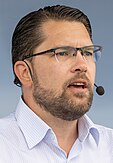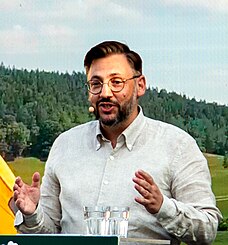General elections will be held in Sweden on 13 September 2026 to elect the 349 members of the Riksdag. They in turn will elect the prime minister. In case of a snap election, the parliamentary term would not be reset and general elections would still be held in September 2026 together with regional and municipal elections.[1][2]
| |||||||||||||||||||||||||||||||||||||||||||||||||||||||||||||||||||||||||||||
All 349 seats to the Riksdag 175 seats needed for a majority | |||||||||||||||||||||||||||||||||||||||||||||||||||||||||||||||||||||||||||||
|---|---|---|---|---|---|---|---|---|---|---|---|---|---|---|---|---|---|---|---|---|---|---|---|---|---|---|---|---|---|---|---|---|---|---|---|---|---|---|---|---|---|---|---|---|---|---|---|---|---|---|---|---|---|---|---|---|---|---|---|---|---|---|---|---|---|---|---|---|---|---|---|---|---|---|---|---|---|
| Opinion polls | |||||||||||||||||||||||||||||||||||||||||||||||||||||||||||||||||||||||||||||
| |||||||||||||||||||||||||||||||||||||||||||||||||||||||||||||||||||||||||||||
| |||||||||||||||||||||||||||||||||||||||||||||||||||||||||||||||||||||||||||||
Electoral system
editThe Riksdag is made up of 349 seats, and all are elected through open list, proportional representation on multi-member party lists.[3]
Of the 349 seats, 310 are elected within the 29 constituencies. The number of members per district ranges from 2 to 40. The remainder - the 39 other members - are apportioned nationally as levelling seats to ensure a proportional result. They are allocated to particular districts.
Were a party to win more constituencies than it is entitled to overall, a redistribution of constituency seats may occur to reduce the number of constituency seats won by that party.[4]
Sweden has the distinction of having elections on a fixed date with a parliamentary system in which early elections can be called. In the latter case, the newly elected legislature would serve the remainder of the four-year term begun by the previous legislature. Elections are organised on the second Sunday of September every four years, at the same time as the municipal and regional elections.[5][6][7]
Each of the 29 constituencies has a set number of parliamentarians that is divided through constituency results to ensure regional representation. The other members of parliament (MPs) are then elected through a proportional balancing, to ensure that the numbers of elected MPs for the various parties accurately represent the votes of the electorate. The Swedish constitution (Regeringsformen) 1 Ch. 4 § says that the Riksdag is responsible for taxation and making laws, and 1 Ch. 6 § says that the government is held responsible to the Riksdag. This means that Sweden has parliamentarism in a constitutional monarchy—ensuring that the government is responsible to the people's representatives. A minimum of 4% of the national vote, or alternatively 12% or more within a constituency, is required for a party to enter the Riksdag. Were the latter to occur, the party only gains representation within that constituency's seat share.
In Swedish elections, voters may openly pick up several party-specific ballots, and then, in the voting booth, use the ballot they choose.
Political parties
editThe table below lists political parties represented in the Riksdag after the 2022 general election.
| Abbr. | Name | Ideology | Political position | Leader | 2022 result | ||
|---|---|---|---|---|---|---|---|
| Votes (%) | Seats | ||||||
| S/SAP | Swedish Social Democratic Party | Social democracy | Centre-left | Magdalena Andersson | 30.3% | 107 / 349 | |
| SD | Sweden Democrats | Right-wing populism | Right-wing to far-right | Jimmie Åkesson | 20.5% | 73 / 349 | |
| M | Moderate Party | Liberal conservatism | Centre-right | Ulf Kristersson | 19.1% | 68 / 349 | |
| V | Left Party | Socialism | Left-wing | Nooshi Dadgostar | 6.8% | 24 / 349 | |
| C | Centre Party | Liberalism | Centre to centre-right | Annie Lööf | 6.7% | 24 / 349 | |
| KD | Christian Democrats | Christian democracy | Centre-right to right-wing | Ebba Busch | 5.3% | 19 / 349 | |
| MP | Green Party | Green politics | Centre-left | Märta Stenevi Per Bolund | 5.1% | 18 / 349 | |
| L | Liberals | Conservative liberalism | Centre-right | Johan Pehrson | 4.6% | 16 / 349 | |
| Independent | 2 / 349 | ||||||
Opinion polls
editGraphical summary
edit
See also
editReferences
edit- ^ "The fundamentals of the electoral system". val.se. Retrieved 19 October 2022.
- ^ Riksdagsförvaltningen. "Elections to the Riksdag". riksdagen.se. Retrieved 19 October 2022.
- ^ "Sweden Riksdagen (Parliament)". Parline. 1 November 2017. Archived from the original on 28 December 2021. Retrieved 31 August 2022.
- ^ "Vallag (2005:837) Svensk författningssamling 2005:2005:837 t.o.m. SFS 2021:1328". Riksdagen (in Swedish). 15 May 2016. Avdelning IV. Fördelning av mandat, 14 kap. Fördelning av mandat, 4 a §. Archived from the original on 30 August 2022. Retrieved 27 August 2022.
- ^ "Elections in Sweden: The way it's done" (PDF). Election Authority. Solna. 7 October 2013. Archived (PDF) from the original on 30 July 2020. Retrieved 31 August 2022.
- ^ "The Swedish electoral system". Valmyndigheten (in Swedish). 16 September 2018. Archived from the original on 16 September 2018. Retrieved 13 September 2018.
- ^ "The 2022 election". Riksdag. 31 August 2022. Archived from the original on 31 August 2022. Retrieved 31 August 2022.
Parliamentary elections will take place on 11 September. On this day voters will have the opportunity to decide which candidates will represent them in the Riksdag over the next four years. On the same day, there are elections to municipalities and regional councils.








